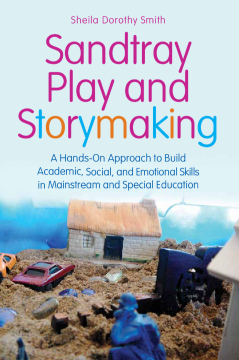
Additional Information
Book Details
Abstract
Introducing sandtray play and storying into mainstream and special education classrooms can have an extremely enriching impact on the learning experience. When used effectively, it can create the climate for social, emotional and behavioural growth and incite bursts of creativity in students.
Build a world in your sandtray; tell its story; record it; listen to your partner's story – these are the invitations to students in a sandtray play/narrative workshop. The benefits of such an approach are endless, from the positive, therapeutic effects of physically displaying emotions through sand worlds to the development of essential speaking, listening and writing skills when telling and recording sand world stories. This accessible and classroom-friendly book explains the thinking behind this unique approach and answers all the nuts-and-bolts questions of sandtray/narrative workshop setup. It offers a wealth of practical methods that can be applied to a wide spectrum of the student population and details real-life anecdotes and student work.
This book is an invaluable handbook for teachers and school counselors looking to use play and storying as a way to develop core competencies in children with special educational needs and in the mainstream, and will also be of interest to play therapists, speech and language therapists and educational psychologists.
I really hope this book is widely read and acted upon, not only by teachers working with children with special needs but those teaching over the fives, many of whom feel forced to push children into writing without their having first had appropriate scaffolding opportunities such as those provided by the author.
Red Reading Hub - Jillrbennett's Reviews of Children's Books
Sheila Dorothy Smith has worked extensively in both mainstream and special education classrooms. She began her teaching career in a Froebel kindergarten, subsequently worked as a parent educator, and for 22 years, as an elementary classroom teacher and special education resource teacher. She has specialist qualifications in Guidance and Special Education, is a training candidate in Sandplay therapy (CAST), and is currently enrolled at the Ontario Institute for Studies in Education as a Masters student in Counseling Psychology. In 2006, Sheila introduced sandtray play and storying to a group of twelve students who were disengaged in the curriculum. Her book is born out of the lively and ongoing results of that experiment. She lives north of Toronto, Ontario.
Sandtray Play and Storymaking is an exquisite book. It is a beautiful portrayal of this therapeutic modality where children, at play in their classrooms with their sandtrays and figurines, construct their own world-making stories filled with ideas, dreams and realities. During this process, a child's feelings and memories can emerge, blending fantasy and life experience.
Shadows of Sylvia Ashton-Warner, Tolkien, Bettelheim and Jung, drift through the narrative alongside the children's written versions of their creations, encouraging readers to find their own sandtrays and begin again.
David Booth, Professor Emeritus, OISE, University of Toronto
There is a sense of treasure emerging through the case studies as the children's voices are allowed to be heard and the sand worlds seen through a child's eyes.
Dramatherapy
This is a brilliant resource. The ideas within this book not only meet the educational components of the curriculum, but also help create a therapeutic space for students to express themselves. The approaches allow children to enjoy the school learning experience and provide teachers with a means to unlock their students' potential.
Sylvia Simonyi-Elmer, Ph.D., psychotherapist, certified sandplay therapist, and senior teacher-supervisor, Kingston, Ontario
This is one of the most exciting and moving educational books I have read in the past 20 years. It emerges out of considerable reflection and hands-on teaching with a wide range of children. The writer takes a developmental perspective that builds on profound symbolic and affective experiences which lead to major advances in the cognitive and social domains. Her approach combines the wisdom of the past with the latest findings from the neurosciences. The methods and suggestions outlined in the book guarantee both excitement and success for pupils and teachers alike. I recommend this book most highly.
John Allan, PhD., Professor Emeritus, Education, University of British Columbia, Vancouver. Author of Inscapes of the Child's World: Jungian Counselling in Schools and Clinics.
Sandtray Play and Storymaking is remarkable! In the book, Sheila demonstrates the extraordinary results that can be achieved through the inclusion of psychological insight in education. Her method of creating, telling and recording sandtray worlds and stories gives children a means to express their inner thoughts and feelings, allows teachers to gain a better understanding of their students and provides the perfect platform for developing literacy skills.
Dr Allan Guggenbühl, psychologist, educationalist and Jungian analyst, University of Education of the State of Zurich
In her book Sandtray Play and Storymaking: A Hands-On Approach to Build Academic, Social, and Emotional Skills in Mainstream and Special Education, Sheila Dorothy Smith issues an invitation to all of us who work with children, especially teachers. She gently challenges us to think outside the box and use what is natural, joy-creating, meaning-making and fun-play, stories and symbols, to develop happier, calmer, more receptive and self-disciplined children. Her approach is evidence based, well researched, practical and useful. It makes sense and it works. Try it and you may even have some fun, too!
Mary Shirley-Thompson, M.A., Manager of Services, Children's Mental Health, Family, Youth and Child Services of Muskoka
